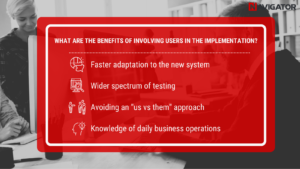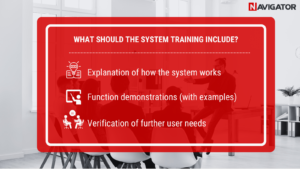The WHO recommends taking 10,000 steps a day. This is the only thing (and as much as the only thing) that separates us from health. And how many steps separate us from successful implementation? You probably already know that from the title. And the answer to the question “What are the steps?” can be found in the article.
Step 1. Accurately determine your needs
Before you start looking for a workflow system, think about what you want to achieve with its implementation. What processes do you want to improve? What benefits do you want to gain? Determining your goals will help you choose the right system and make it easier to evaluate its effectiveness after implementation.
Sample questions you can ask yourself:
What processes in the company are time-consuming and inefficient?
What mistakes are often made in manual processes?
What information is often lost or transmitted late?
What documents are often printed, copied and archived?
Step 2. Choose the right system
There are many workflow systems available on the market, varying in features, price and ease of use. If you have answered the previous questions, it will certainly be easier to match a system to your needs.
However, it is important to also consider factors such as:
– Features: does the system offer all the features you need?
– Ease of use: will the system be easy for your users to use?
– Integration: does the system integrate with other tools you use?
– Price: what is the cost of the system and does it fit within your budget?
– Provider: does the provider offer good support and training?
It would be best to confirm each factor in two different sources. For example, online reviews say the system is easy to use but also check this with a trial version.
Step 3. Involve multiple users
The users of the workflow system must be involved in the implementation process. Particularly operations and HR staff, whose knowledge of daily business operations is essential to ensure that the system meets the real needs of the company.
In addition, involving users will help them adapt to the new system more quickly.
It is worth including not only managers and “top employees” in the testing. It is assumed that those in this “elite group” are most likely to find and point out problems. In practice, employees with different skill levels and job responsibilities face different obstacles.
This solution also avoids divisions. We change the “us vs. them” perspective to “one for all.”

Step 4. Wait to launch the production environment
Determining when to complete testing requires effective communication and full cooperation between:
– company management,
– the IT department,
– departments that are subject to automation processes
– provider.

The implementation of an office automation solution should be planned and implemented gradually. It is especially important to conduct tests in the early stages of the process. This should be done as often as possible.
Focused testing avoids unforeseen problems that could affect the efficiency of the system in the future.
“Prevention is better than cure” – this principle also applies in implementations.
Step 5. Ensure knowledge transfer
Users need adequate support and training to use the new workflow system effectively. Training should include:
– explanation of operation,
– demonstration of functions,
– verification of further user needs.

Ongoing support helps users deepen their use over time. Lack of training will, in turn, lead to difficulties in using the system. This can translate into resistance to its use and overall low user acceptance.
In a nutshell
Implementation is a unique time in the life cycle of any company. It is worth carving out more time for this project, perhaps letting go of side tasks for a while. Providers spend days (and often nights) making sure the whole process runs smoothly, but success depends on the involvement of all stakeholders.
Each implementation is a separate story. Together, you can make it have a happy ending.
Sources:
https://www.medicalnewstoday.com/articles/how-many-steps-should-you-take-a-day
Computational Engineering graduate and master’s student majoring in Computer Science and Econometrics at AGH University of Science and Technology. In the company, she combines the work of a junior Workflow systems specialist with the role of programmer. She is responsible for implementing NAVIGATOR for, among others, a Latvian client. Programming has become her passion, and so she constantly expands her knowledge in programming language C#. If she isn’t working or programming, she plays basketball.





